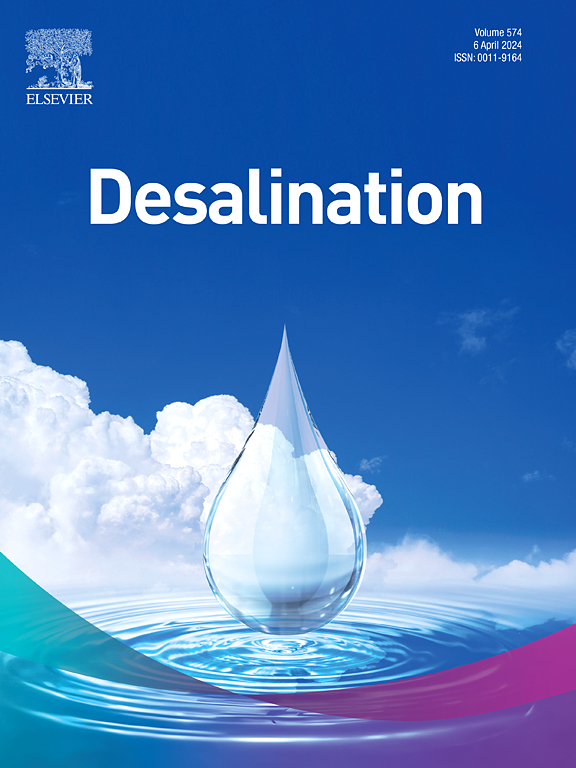Can lignin nanosphere be used as a recycled sacrificed template for constructing high performance loose nanofiltration membranes?
IF 8.3
1区 工程技术
Q1 ENGINEERING, CHEMICAL
引用次数: 0
Abstract
Sacrificed template strategy has become a promising pathway to construct high performance loose nanofiltration (LNF) membranes for dye-containing wastewater treatment. However, few studies have been conducted on the recycling of templates in the LNF membrane preparation. In this study, lignin nanoparticles (LNPs) with abundant biomass sources, low cost, renewable ability, were attempted to be used as a recycled sacrificed template for the first time. The LNPs were easily renewed by concentration and NaOH dialysis with smaller nano-size and more hydrophilic surface. The optimized P-LNF-50 membrane prepared by pristine LNPs templates exhibited high water permeability of 146.24 LMH·bar−1, excellent separation of dye/salt (i.e. rejection: 97.79 % for CR, 0.48 % for Na2SO4, 0.25 % for NaCl), and superior long-term stability. Interestingly, the R1-LNF-70 membrane prepared by 1st recycled LNPs templates can still maintain high water permeability of 132.97 LMH·bar−1 and excellent separation of dye/salt (i.e. rejection rate: 98.31 % for CR, and 1.27 % for Na2SO4). While the 2nd recycled LNPs can not produce satisfied LNF membranes due to its poor figuration and easy aggregation. The inherent relationships between LNPs templates and selective layers were deeply explored. Importantly, the Sankey chart of recycling LNPs template technique and cost analysis indicated that the LNPs could be used as green templates for two cycles with comparable permeability and selectivity of dye/salts. Overall, our study paves the way for recycling of sacrificed templates for the scalable fabrication of high performance LNF membranes.

木质素纳米球能否作为可回收的牺牲模板用于构建高性能的松散纳滤膜?
牺牲模板策略已成为构建高性能松散纳滤(LNF)膜处理含染料废水的一种有前景的途径。然而,关于模板在LNF膜制备中的回收利用的研究很少。本研究首次尝试将生物质来源丰富、成本低、可再生的木质素纳米颗粒(LNPs)作为可回收的牺牲模板。LNPs具有纳米尺寸更小、表面亲水性更强的特点,易于通过NaOH透析和浓度透析进行更新。采用原始LNPs模板制备的P-LNF-50膜具有146.24 LMH·bar−1的高透水性,具有良好的染料/盐分离性能(CR的去除率为97.79%,Na2SO4的去除率为0.48%,NaCl的去除率为0.25%),并且具有良好的长期稳定性。有趣的是,由第一次回收LNPs模板制备的R1-LNF-70膜仍然保持132.97 LMH·bar−1的高透水性和良好的染料/盐分离(即CR的去除率为98.31%,Na2SO4的去除率为1.27%)。而二次循环LNPs由于其形态差,容易聚集,不能生产出满意的LNPs膜。深入探讨了LNPs模板与选择层之间的内在关系。重要的是,再生LNPs模板技术的Sankey图表和成本分析表明,LNPs可以作为绿色模板用于两个循环,具有相当的渗透性和染料/盐的选择性。总的来说,我们的研究为可扩展制造高性能LNF膜的牺牲模板的回收铺平了道路。
本文章由计算机程序翻译,如有差异,请以英文原文为准。
求助全文
约1分钟内获得全文
求助全文
来源期刊

Desalination
工程技术-工程:化工
CiteScore
14.60
自引率
20.20%
发文量
619
审稿时长
41 days
期刊介绍:
Desalination is a scholarly journal that focuses on the field of desalination materials, processes, and associated technologies. It encompasses a wide range of disciplines and aims to publish exceptional papers in this area.
The journal invites submissions that explicitly revolve around water desalting and its applications to various sources such as seawater, groundwater, and wastewater. It particularly encourages research on diverse desalination methods including thermal, membrane, sorption, and hybrid processes.
By providing a platform for innovative studies, Desalination aims to advance the understanding and development of desalination technologies, promoting sustainable solutions for water scarcity challenges.
 求助内容:
求助内容: 应助结果提醒方式:
应助结果提醒方式:


